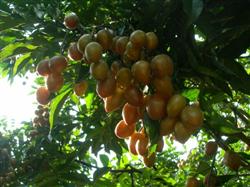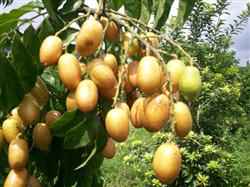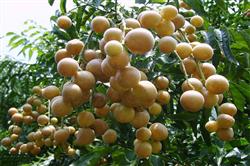How to control the main diseases and insect pests of wampee?

How to control the main diseases and insect pests of wampee? Please introduce the main diseases and insect pests of wampee can be controlled by the following methods: 1. Anthrax is a common disease in production, which is susceptible in all growth stages, and it has occurred more seriously from June to October in recent years. Prevention and control methods: scientific use of fertilizer and water, enhance the tree potential, pay attention to timely drainage after rain to prevent bacterial infection. To achieve rural cleanliness, timely cut off diseased branches, diseased leaves, deal with rotten fruit, reduce the source of overwintering disease. The medicament can be selected as 800 / 1000 times of 70% topiramate wettable powder, 500 times of 50% carbendazim 500 × 600 times, 5% chlorothalonil 700 × 1000 times or 50% carbendazim 500 times. 2. Coffee leopard bark moth often harms new shoots, flowers and fruit ears. The larvae overwintered in the damaged branches, and in late February of the following year, the overwintering larvae began to feed in the branches, excreted feces out of the hole, pupated from March to May, and the adults emerged from April to mid-July. The adults lay eggs from late April to early June, the newly hatched larvae drill into the trunk in early May, and the peak period is from early June to late October. Prevention and control methods: often visit the garden, cut off the insect branches and burn them in time, or stab the larvae and pupae in the insect track with iron wire; inject 80% dichlorvos EC 100 times into the moth channel and seal the hole with clay. 3. The white moth wax cicada is commonly known as "white chicken". Often adults and nymphs gather on branches, tender shoots, spikes and pedicels to suck up juice. Control methods: clear the orchard in winter, combined with pruning, keep the orchard and canopy ventilated and transparent, reduce the harm and reduce the insect source; in the first ten days of March and the middle and late July, the adults are sprayed at the early stage of spawning and the nymphs are sprayed at the low age of nymphs. It can be controlled with 800-1000 times of 80% dichlorvos EC, or 1000 times of 90% crystal trichlorfon, 40% dimethoate EC, 50% malathion EC, or 2000 times of 10% dichlorvos EC. 4. The main aphids harmed by aphids are orange aphid, cotton aphid, Spiraea chrysanthemum aphid and so on. Adults and nymphs cluster on buds, shoots, young leaves, buds and young fruits to suck up juice. Prevention and control methods: combined with pruning after fruit harvest and garden cleaning in winter, cut off the overwintering eggs and insects, concentrate on burning, reduce spraying, protect natural enemies, and make use of natural enemies to reduce damage. When the damage rate of new shoots is more than 25%, spray control can be carried out with 3000 times of 10% cypermethrin EC or 3000 times of 2.5% deltamethrin EC. 5. Leaf miner is also known as Ghost Picture symbol. The pupae or a few mature larvae overwintered at the leaf edge, and the overwintering pupae emerged into adults in late April of the following year, which began to damage in May and the summer and autumn shoots from June to August. Prevention and control methods: strengthen agricultural management, control the application of nitrogen fertilizer, make the new shoots grow neatly, which is beneficial to the centralized spraying to protect the shoots. The new shoots were sprayed 5-7 days after emergence, once every 7-10 days, 1 spray twice, and can be prevented and treated with 2.5% deltamethrin EC 2000-3000 times. Click for more wampee planting techniques click to get more fruit planting techniques
- Prev

How to grow the yellow skin of chicken heart?
How to grow the yellow skin of chicken heart? Please guide the cultivation of chicken heart yellow skin can refer to the following methods: first, the main cultivated varieties. At present, the main cultivated varieties are chicken heart yellow skin, selected big chicken heart yellow skin and so on. Second, wampee's requirements for environmental conditions ⑴ temperature: annual average temperature of more than 20 ℃, January average temperature of 12.
- Next

Which diseases and insect pests should be controlled when planting wampee?
Which diseases and insect pests should be controlled when planting wampee? Please introduce the main diseases and insect pests in wampee planting as follows: 1. Wampee anthracnose is a common disease in production, which is susceptible to leaf spots, leaf rot, bald branches, flower rot and fruit rot in all growth stages. If wampee is interplanted with other crops.
Related
- Moge, come on! The staff of the peasant association in the producing area of cantaloupe were frightened when the crowd gathered.
- Causes and Solutions of low Fruit setting rate of Apple
- Symptoms and control measures of passion fruit virus disease
- Fruit growing lesson: how do apple orchards keep high yields?
- Can you build orchards in the mountains? What are the pros and cons?
- How to manage the coloring period of Crisson grape?
- This paper introduces the processing technology of two kinds of fig products.
- How much is a month for retired teachers in rural areas by 2020?
- How can strawberry planting increase sugar content? We should pay attention to management in many aspects.
- What are the cultivation techniques on how to improve the yield of golden fruit?

